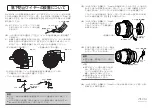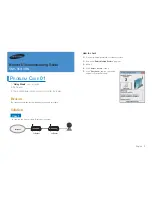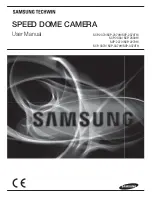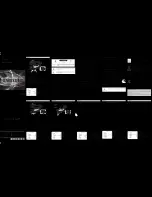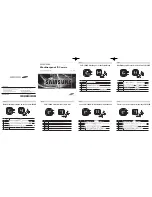
42
H/V BALANCE:
You can choose the ratio for horizontal and vertical contour correction signal elements.
Choose a value from
–2 to 0 to +2. When you choose a higher value, the horizontal contour correction elements
become greater compared to the vertical elements.
B/W BALANCE:
You can adjust the balance between contours in black on the low brightness side of the
spectrum and contours in white on the high brightness side. Choose from TYPE1 to TYPE5. The ratio of
contours in black is higher for
TYPE1 while the ratio of contours in white is higher for TYPE5.
LIMIT:
You can set the maximum value for the amount of contour emphasis in black on the low brightness side
of the spectrum and in white on the high brightness side. Choose a value from 0 to 7.
HIGHLIGHT DETAIL:
You can adjust the level of contour added to brightly-lit objects. Choose a value from 0 to
4. Adjust this when you want to emphasize the contour of a brightly-lit object in a bright background.
SUPER LOW:
Emphasizes contours in the super low range. Choose a value from 0 to 7. The greater the value,
the greater the contour emphasis. Contrast and resolution increase.
PICTURE Menu
Noise Reduction (NR)
The NR function removes noise (both random and non-random) to provide clearer images. This function has
six steps: levels 1 to 5, plus off. The NR effect is applied in levels based on the gain, and this setting value
determines the limit of the effect. In bright conditions, changing the NR level will not have an effect. When it is
set to level 7Fh, you can set NR of 2D/3D individually.
2D NR:
2D Noise Reduction is a method of reducing noise within an image by comparing frame-to-frame, removing
the variations that do not appear in each frame
3D NR
3D Noise Reduction is a method of reducing noise by
comparing variances within the same frame, as well as
comparing frame-to-frame. This will reduce noise
without leaving trails behind a moving object.
FLIP:
Image E-Flipper
– Used when ceiling mounting or
upright mounting. Set to OFF is upright mode, set to
ON is for ceiling mount.
MIRROR:
You can have the image as seen in a mirror, with
the right side as though it were the left.
COLOR
You can configure the color gain from 1-15. Use this setting when bright color is particularly important.
HUE
You can adjust color phase from 1-15.
ND FILTER:
The ND Filter installed in front of the CMOS image sensor can be engaged or disengaged by the mechanical
structure. The adjustable range of Iris and shutter speed are increased by using the ND Filter.
There are 2 types of ND Filters, and by combining them, the light quantity can be used at 1× (Filter Off), 1/4×,
1/16×, or 1/64×.
IR CUT FILTER
An infrared (IR) Cut-Filter can be disengaged from the image path for increased sensitivity in low light
environments. The ICR will automatically engage depending on the ambient light, allowing the camera to be
effective in day/night environments. When the auto ICR mode is set to NIGHT, the image becomes black and
white.
CHROMA SUPPRESS (Low-Illumination Chroma Suppress Mode)
You can configure a Chroma suppress mode for low illumination conditions. This can be useful when color
noise is particularly noticeable in such conditions. Four levels (disabled and three levels) are available for the
low-illumination Chroma suppress mode.
You can set the brightness from OFF, LOW, MID, HIGH
HLC MODE
HLC (Highlight Light Compensation) is a function to adjust AE and AF, and to perform the masking of light
area as required when a high intensity spot light is detected.
STABILIZER
EXPOSURE
WHITE BALANCE
DETAIL
>PICTURE
GAMMA
NETWORK
PAN TILT ZOOM
>
SYSTEM
OSD
2D NR
2
3D NR
2
FLIP
OFF
MIRROR
OFF
COLOR
5
HUE
8
ND FILTER
OFF
IR CUT FILTER
DAY
CHROMA SUPPRESS
OFF
HLC MODE OFF
STABILIZER OFF
PICTURE MENU
Summary of Contents for BC-9 Series
Page 9: ...9 Camera Diagrams ...
Page 32: ...32 Optical Video Output Card ...
Page 54: ...54 ...
Page 55: ...55 ...
Page 56: ...56 Dimensions Unit mm ...
Page 57: ...57 www bolintechnology com 2082 TECHNOLOGY LLC dba BOLIN TECHNOLOGY ...































